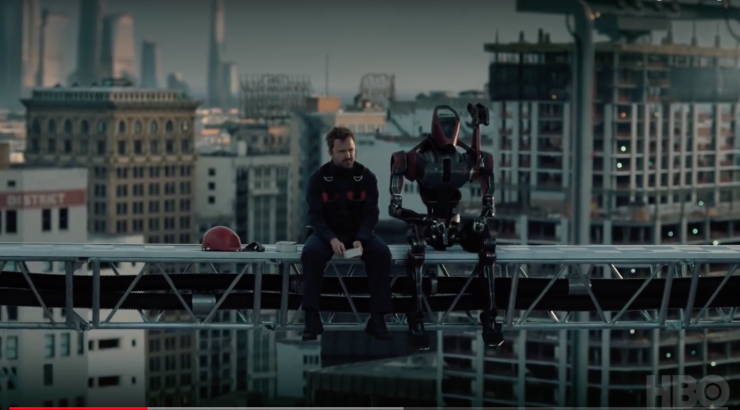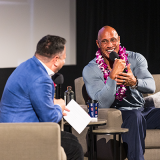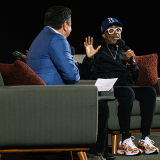Chapman Reunion on HBO’s WESTWORLD Not one, not two, but three Production Design alumna working on the hit show!
September 17, 2019
Three alumnae from Dodge College’s MFA in Production Design program have gone on to work on television programming. They each had different paths that led them to HBO’s Westworld and we had an opportunity to hear their stories.
Rachel Aguirre ’13 (RA)
Rebekah Scheys ’15 (RS)
Tarn Lerdjarudech ’16 (TL)
How did you land your job on Westworld?
TL: Rebekah Scheys contacted me when the show started to look for the 3rd assistant art director. I met Rebekah on my very first day of grad school. She was a year above me. We didn’t really have classes together but we saw each other at Dodge all the time while we were there as both of us were production design students. At this point, I would say, we start to have a good connection.
RS: I first came on the show at the end of Season 2 to help finish out the last few weeks of that season. I joined the show originally through an Art Director who I had worked with on a different project, as an Art Department PA. He knew that I had since joined the union and was working as an Assistant Art Director, so he recommended me for the job. I found that I really loved both the particular challenges of the show and also everyone that I worked with in the Art Department, so I was glad to be able to come back for Season 3.
RA: I was recommended by Rebekah and I already knew our Set Designer, Dan, so he put in a good word for me too.
What is the function of your department?
TL: Art Department is responsible for creating the overall look for the show. We design, build, and decorate the sets on which the actors shoot, being mindful of every little detail that can support the director’s vision. On Westworld Season 3, the Art Department has one of the biggest crews out of the whole production. The showrunner/writers create ‘the new world’ for this season so we have a lot of creative art crews to visualize what the future world would look like.
RS: The Art Department designs and creates all of the sets for the show. The Production Designer, our department head, will create the look and come up with the initial design, and then the rest of us will work on realizing that design through creating concept illustrations, signs/graphics, and working drawings that the construction department will be able to physically build the sets from.
RA: The job of the Art Department is to concept and create the environment on screen. This is a bit vague, so to break it down: Howard Cummings, our Production Designer, concepts a design with our Illustrators. When the team gets approval, Set Designers draw up the plans to make the dream a reality. The Art Directors communicate to all other departments to facilitate the process. We work side-by-side with the Set Dec Department as well. After Art Department creates the set, Set Dec adds character detail to it with furniture and decor.
What are your roles and responsibilities as art directors?
TL: As an assistant art director, I help the art directors and production designer oversee the look of the sets, making sure that the sets are ready for shooting. The process starts with going to see a location and draw a director plan. I help the art director communicate with all departments that are involved such as construction, scenic, set dec, green, and even lighting to bring everything together and get the look of the set as close as what the production designer’s vision it to be.
RS: Art Directors do everything from sourcing materials and hardware for building the sets, to measuring and drawing up plans of locations, to walking through the sets as they’re being built to make sure that everything is going according to plan. The day-to-day work can vary, but one part of an Art Director’s role that stays consistent is communication- both helping to manage communication between all of the outside departments that will be interacting with the set (depending on what the set is, it could have elements that require help from Special FX, Stunts, Fixtures/Lighting, Picture Cars, Video Playback, Visual Effects, etc.) and also ensuring that each of the departments that are connected to us (Set Decoration, Props, Construction, Paint, Plaster, Greens) know what is needed from them for the given set and will be able to provide it. We create a lot of work notes, graphic layouts, etc. and have a lot of conversations both via email and in-person to make sure that everyone is on the same page about what will be built on a stage or installed in a location, and what the finished product should look like.
RA: Specifically, as an Assistant Art Director, I help the Art Director as they facilitate the process of building the set.
Could you walk us through the process of your projects on Westworld?
RS: Typically, we will begin the design process with a concept and the knowledge of whether this set will be built on a sound stage, or in a location. Then, an Illustrator will begin creating a digital painting to represent (and sometimes to help pitch) the finished look, in tandem with a Set Designer beginning to create construction drawings to flesh out the size of the set and the materials that will be required, and sometimes also creating a 3D model of the space. Once the design is finalized and the set begins to be built, the Art Director will continue to source remaining materials, address concerns with other departments, and walk the set to ensure that the construction, paint finishes, and all other elements of the set are being completed as desired. The Director, DP, Gaffer, Key Grip, etc. are all made aware of changes to the set as they happen throughout the development process, and when the crew arrives at the set on the day, either the Production Designer or Art Director will typically walk the Director and DP through the set to show them everything that was done.
RA: Every episode we get a breakdown of which Art Directors are assigned to each set. Typically I’m teamed up with one Art Director, but on busier episodes it could be two or three that I’m working with. The Art Director(s) will work with our Set Designers to create drawings for the set pieces that need to be built. After the drawings are approved and released, I source hardware and specific materials needed. I’ll read the drawings to see how much square footage we’ll need and research the cost for it. I’ll send that to construction for budget approval and they’ll take it from there. I also survey locations, create directors plans, and on occasion, I’ll Art Direct a location if the schedule becomes too busy for that one to be taken by someone else.
Had any of you met each other or worked with each other before Westworld?
RS: I had actually never worked with either Tarn or Rachel before, but had met both of them at Chapman. I knew Tarn because we attended the Production Design program at the same time (she was in the year below me), and I had seen her in the years since at school events. Rachel had attended the Production Design program a few years before Tarn and me, but I met her when she came back to speak to my class one year, as an alumna. Westworld is somewhat rare in that it has a very large art department compared with a typical television show, so we have several Art Directors and several Assistant Art Directors (nearly ten total). Typically, if you are working as an Assistant Art Director, you wouldn’t normally be in a position to recommend other Assistant Art Directors for the same show, since there would be only one available role, but in this case, it worked out that all three of us were able to work together, since the show had three available positions.
RA: I met Rebekah when I came back to speak at Chapman, post-graduation. I didn’t meet Tarn until Westworld, and I hadn’t worked with either of them till now. It’s a really great experience to work with two women with the same alma mater. They’re both extremely creative and It’s a joy to work with them! In a field that’s male-dominated, It’s quite inspiring to work on a team that has so many amazing women.
What is the most exciting project you’ve worked on so far and what are you looking forward to next?
TL: Before Westworld, I’ve worked on a new feature film, ‘Ford VS Ferrari’ produced by 20th Century Fox. It was a super cool project about how Ford beat Ferrari during Le Mans racing in 1966.
RS: Westworld is definitely high on the list, as far as being a show that has such incredible scope, and that constantly challenges me and teaches me new things. This is also one of the best art departments that I’ve worked in since all of us work so well together. As far as what I’m looking forward to next, I recently transitioned from being an “Assistant Art Director” on the show to an “Art Director” (which is essentially the same job, just with greater responsibility). I’m excited about the additional challenges that that shift will bring, and be able to continue to grow in this position while I’m working in an environment that’s so supportive and stimulating.
RA: This one! I love working on Westworld because it combines science fiction, suspense, horror, and gore all into one sleek package. I’m looking forward to working with this team again!
How has your education and experience at Dodge prepared you for your career?
TL: As a production design student at Dodge, I learned the fundamental collaboration with the other department peers, helping me understand what each department does when we form a group project to make a small short film. I learn how to draft/draw and design sets from scratch and make it into reality or as close as it could be with the budget provided. When I started to work on a big show or big feature, I understand how production works very well. The process of film making is still similar but way bigger and involved with more techniques and more people.
RS: Apart from the fact that every day I use the technical skills that I learned at Dodge, I think that the process of working on high-level student films and learning how to relate with other departments, albeit on a small level, helped start developing the communication skills that I now use constantly. Also, the design portfolio that I left Chapman with was largely what enabled me to join the apprenticeship program which helped me to join the union and to start to build a network of contacts in the film industry, despite having no previous connections.
RA: Dodge gave me an opportunity to work with extremely driven and creative people. I wanted to take advantage of not only learning more about Production Design but also take the time to meet other students that I might work with outside of Chapman. I worked on two really fun thesis projects: Brightside: a 1940’s musical and If We Were Adults: a contemporary comedy. Both of these needed to be designed with a very tight budget in mind.
Tips and advice for current students at Dodge who are hoping to break into film/ television?
TL: Connection at Dodge is one of the most important things I got out of grad school because it’s all about teamwork when you are in this industry. We always bring people we know into the industry. Work hard, keep learning every day and don’t reject even just a small one day job as a PA on set because you would never know who you will meet. That person could get you on something else that is bigger or help you succeed.
RS: I would say, when you first finish school, just do anything and everything. Smaller, indie projects where you are able to do a lot are good for developing your creativity and ingenuity, but you should also try to get onto the most professional sets that you can- even if it’s just temporarily, even if it’s as an intern or a PA- because it will help tremendously with learning how everything works at a professional level and will build your contacts in that world. It never hurts to cold email people in the industry who you might have a slight connection to or who you admire, but it’s hard to count on someone giving you a big break when they don’t know you yet. Most, if not all, of the jobs I’ve gotten have been because I knew someone already on the show who recommended me, and a recommendation from just one person can be worth far more than having the perfect reel or portfolio. Developing those things is important also, but I think it’s just as important to be a good team player and someone who is easy to get along with and takes direction well. People who are both talented and easy to work with are harder to come by than you might think, and if you work as much on communicating well, being respectful, and getting along with other people as you do on your craft, plenty of people will remember that and want to hire you again.
RA: 1. Make stuff! It’s important for someone to learn by doing in this profession. Especially with Art Department- having experience building and painting helps you to better understand and communicate with construction and painters. Tap into your creativity and express yourself.
2. Watch stuff! Go see an opera, watch movies (old and new), go to art museums, live shows, etc. The more you see and experience, the more you bring to the table when you’re looking for references or inspiration.
3. Be a self-starter. This job is all about managing one’s time and effort as well as managing those who work under you. Learn to be self-motivated and independent, because you’re not always going to be an assistant.



